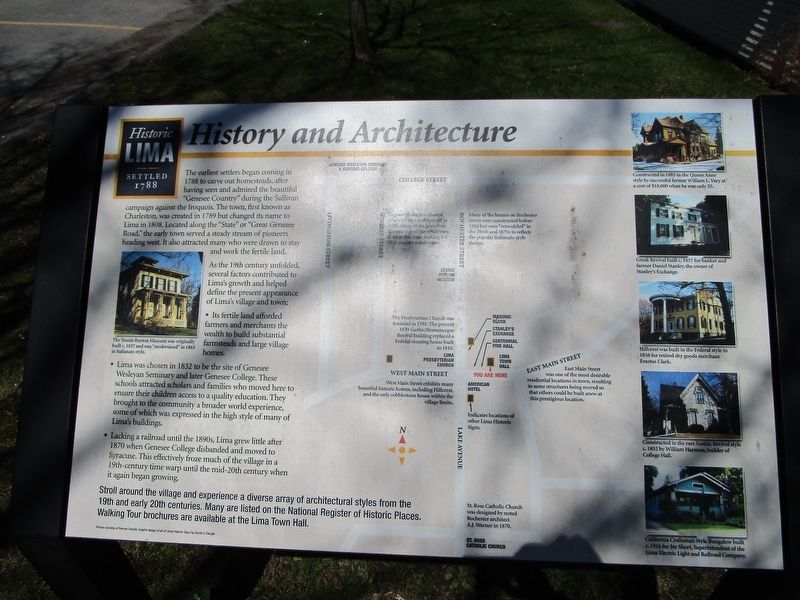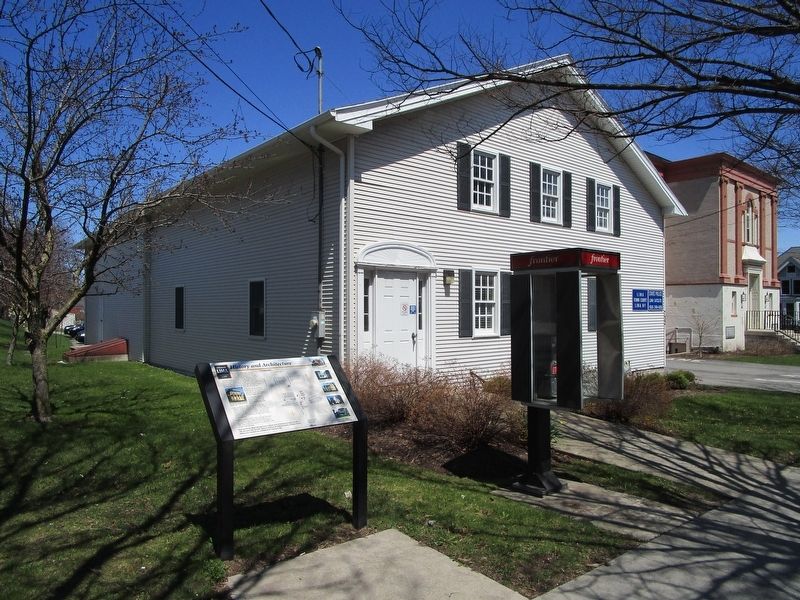Lima in Livingston County, New York — The American Northeast (Mid-Atlantic)
History and Architecture
Historic Lima - Settled 1788
Historic Lima, Settled 1788
History and Architecture
The earliest settlers began coming in 1788 to carve out homesteads, after having seen and admired the beautiful “Genesee Country” during the Sullivan campaign against the Iroquois. The town, first known as Charlestown, was created in 1789 but changed its name to Lima in 1808. Located along the “State” or “Great Genesee Road,” the early town served a steady stream of pioneers heading west. It also attracted many who were drawn to stay and work the fertile land.
As the 19th century unfolded, several factors contributed to Lima’s growth and helped define the present appearance of Lima’s village and town:
• Its fertile land afforded farmers and merchants the wealth to build substantial farmsteads and large village homes. • Lima was chosen in 1832 to be the site of Genesee Wesleyan Seminary and later Genesee College. These schools attracted scholars and families who moved here to ensure their children access to a quality education. They brought to the community a broader world experience, some of which was expressed in the high syle of many of Lima’s buildings.
• Lacking a railroad until the 1890s, Lima grew little after 1870 when Genesee College disbanded and moved to Syracuse. This effectively froze much of the village in a 19th-century time warp until the mid-20th century when it again began growing.
[map] Genesee Street was created when College Hall opened in 1851. Many of the homes in the east side of the street were built at this time, making it a 19th century subdivision.
Many of the homes on Rochester Street were constructed before 1850 but were “remodeled” in the 1860s and 1870s to reflect the popular Italianate-style design.
The Presbyterian Church was founded in 1795. The present 1873 Gothic/Romanesque Revival building replaced a Federal meeting house built in 1816.
West Main Street exhibits many beautiful historic homes, including Hill crest, and the only cobblestone house within the village limits.
East Main Street was one of the most desirable residential locations in town, resulting in some structures being moved so that others could be built anew at this prestigious location.
St. Rose Catholic Church was designed by noted Rochester architect A.J. Warner in 1870.
[captions] The Tennie Burton Museum was originally built c. 1837 and was “modernized” in 1863 in Italianate style.
Constructed in 1885 in the Queen Anne style by successful farmer William L. Vary at a cost of $18,000 when he was only 25.
Greek Revival built c. 1857 for banker and farmer Daniel Stanley,
the owner of Stanley’s Exchange.
Hillcrest was built in the Federal style in 1838 for retired dry goods merchant Erastus Clark.
Constructed in the rare Gothic Revival Style c. 1852 by William Harmon, builder of College Hall.
California Craftsman Style Bungalow built c. 1916 for Jay Short, Superintendent of the Lima Electric Light and Railroad Company.
Stroll around the village and experience a diverse array of architectural styles from the 19th and early 20th centuries. Many are listed on the National Register of Historic Places. Walking brochures are available at the Lima Town Hall.
Topics. This historical marker is listed in this topic list: Architecture. A significant historical year for this entry is 1788.
Location. 42° 54.314′ N, 77° 36.654′ W. Marker is in Lima, New York, in Livingston County. Marker is on East Main Street (New York State Route 5) 0.1 miles east of Rochester Street (New York State Route 15A), on the right when traveling west. Touch for map. Marker is at or near this postal address: 7321 East Main Street, Lima NY 14485, United States of America. Touch for directions.
Other nearby markers. At least 8 other markers are within walking distance of this marker. Francis M. Dalton (within shouting distance of this marker); Repulse Fire Co. (within shouting distance of this marker); Lima Bank Robbed (within shouting distance of this marker); Gandichiragou (within shouting distance of this marker); Union Lodge No. 45 (within shouting distance of this marker); A 17th-Century Iroquois Village (about 400 feet away, measured in a direct line); Kenneth B. Keating (approx. 0.2 miles away); Genesee Wesleyan Seminary (approx. ¼ mile away). Touch for a list and map of all markers in Lima.
Credits. This page was last revised on May 1, 2018. It was originally submitted on May 1, 2018, by Anton Schwarzmueller of Wilson, New York. This page has been viewed 393 times since then and 64 times this year. Photos: 1, 2. submitted on May 1, 2018, by Anton Schwarzmueller of Wilson, New York.

